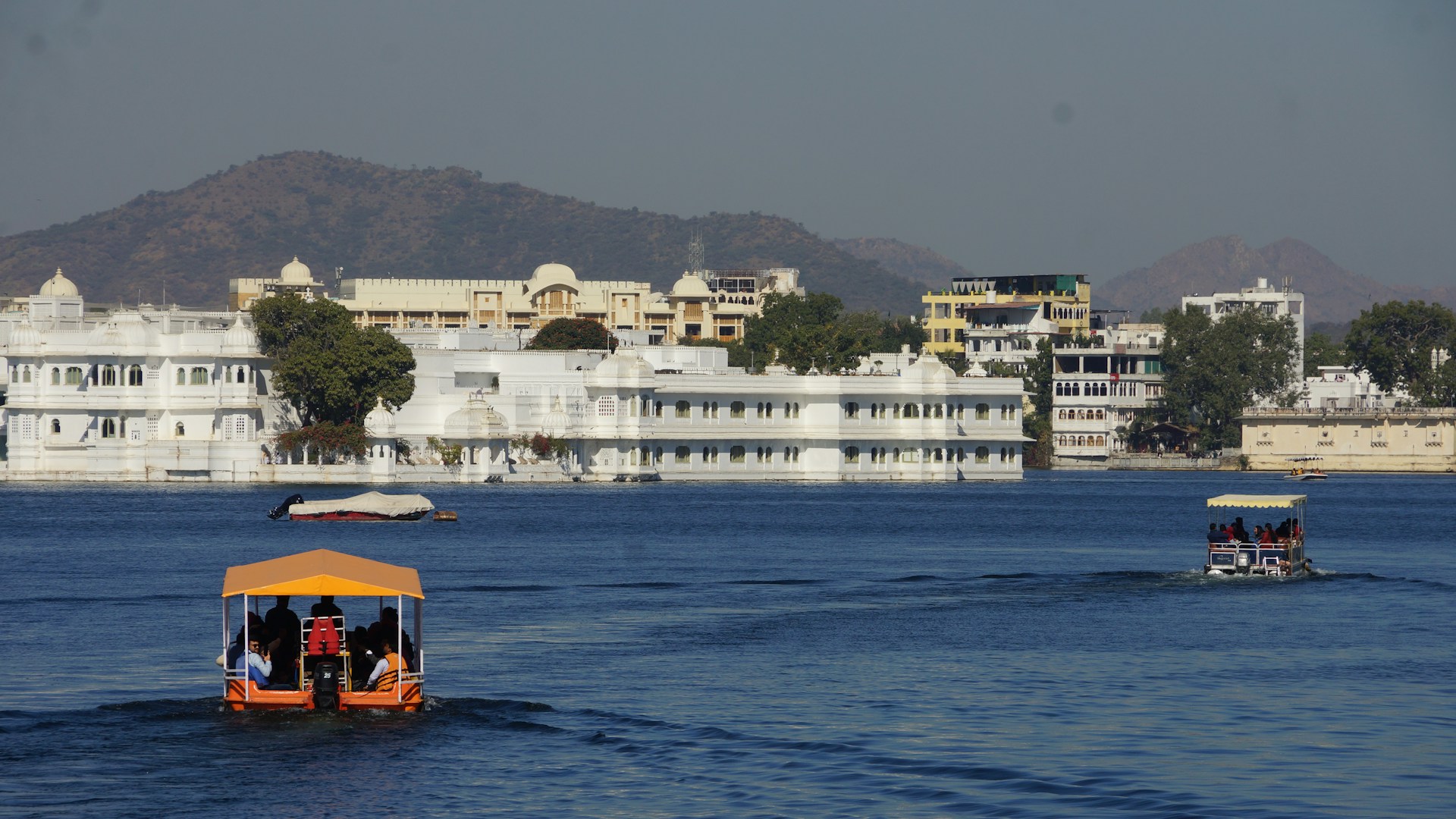Udaipur travel between October and March, when Udaipur is at its most charming, to truly experience its wonderful appeal.
This time of year provides perfect weather for visiting the city’s magnificent palaces, serene lakes, and lively markets because of the beautiful skies and pleasant temperatures.
Spend these lovely months immersing yourself in Udaipur’s beauty and culture rather than enduring the intense summer heat or the deluges of the monsoon season.
Throughout the winter, Udaipur entices with its timeless charm and gracious hospitality, whether you’re cruising on the tranquil waters of Lake Pichola or meandering through the old city’s medieval streets.
Let’s find some best places to visit in Udaipur.
Table of Contents
1. City Palace (One of the Best Places to visit in Udaipur)
Situated in the center of Udaipur, Rajasthan, on the banks of Lake Pichola, City Palace udaipur is a vast complex that commands attention from throughout the city.
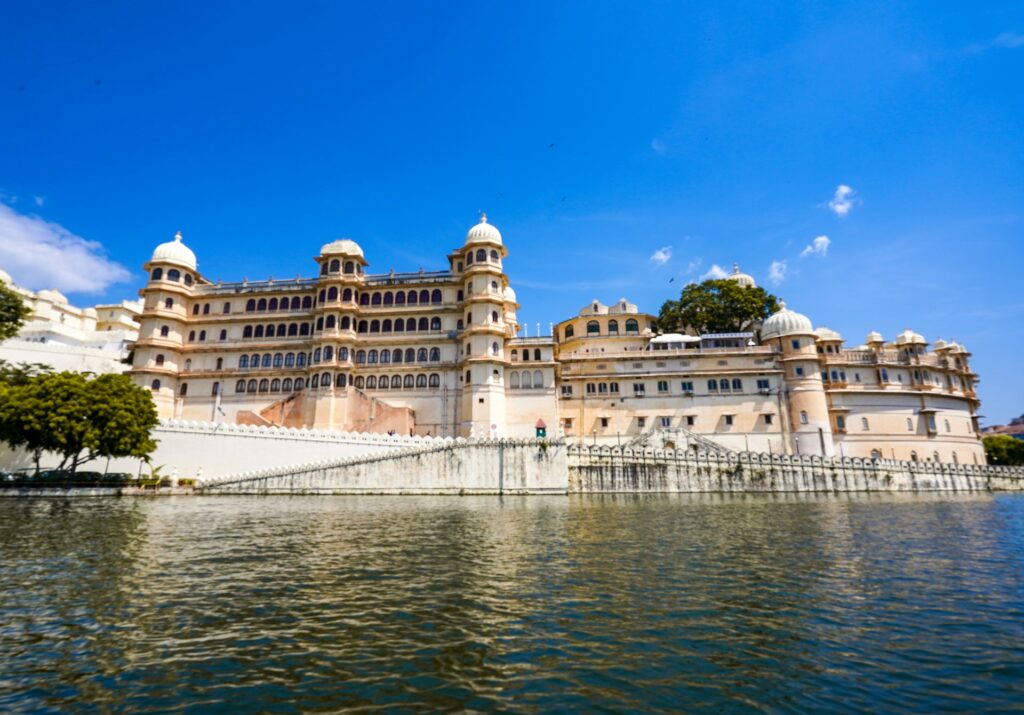
History:
The construction of the City Palace stretched several centuries, beginning in 1559 at the establishment of Udaipur by Maharana Udai Singh II. The palace structure was expanded over time by succeeding monarchs, culminating in a magnificent blend of Rajput, Mughal, European, and Chinese architectural styles.
Architecture:
The palace, which features finely carved balconies, domes, and arches that highlight the wealth and magnificence of the Mewar dynasty, is a marvel of architectural genius. The expansive palace complex is a maze-like arrangement of gardens, pavilions, courtyards, and hallways that each provide a window into Rajasthan’s rich past and cultural legacy.
Highlights:
Mor Chowk: One outstanding aspect of the palace is the Peacock Courtyard. It has been decorated with exquisite mosaics showing peacocks.
Manak Mahal: The Ruby Palace is home to an amazing assortment of royal relics, including priceless porcelain and crystal.
Sheesh Mahal: Thousands of delicate mirrors create an amazing image throughout the Palace of Mirrors.
Jagdish Temple: Known for its beautiful carvings and magnificent architecture, the Jagdish Temple is located next to the royal complex and is devoted to Lord Vishnu.
Visitor Experience:
Explore the many galleries, museums, and gardens at City Palace to learn more about the rich cultural legacy and history of the Mewar dynasty. There are organized tours that offer insights into the artwork, architecture, and royal lifestyle of the palace.
Practical Information:
Opening Hours: City Palace is open to visitors from 9:30 AM to 5:30 PM every day.
Entry Fee: The entry fee varies for Indian and international tourists, with additional charges for camera usage.
Accessibility: The palace is wheelchair accessible, and audio guides are available in multiple languages for visitor’s convenience.
Conclusion:
City Palace is a living reminder of the Mewar dynasties and Udaipur’s illustrious past. It is more than just a monument. A visit to City Palace transports you back to the heyday of Rajasthani royalty with its majestic architecture, eye-catching artwork, and expansive vistas of Lake Pichola.
2. Lake Pichola
Nestled amidst the Aravalli hills in the heart of Udaipur, Rajasthan, Lake Pichola is a charming of human origin lake that epitomizes the city’s charm and beauty. This is one of the best lake in udaipur.
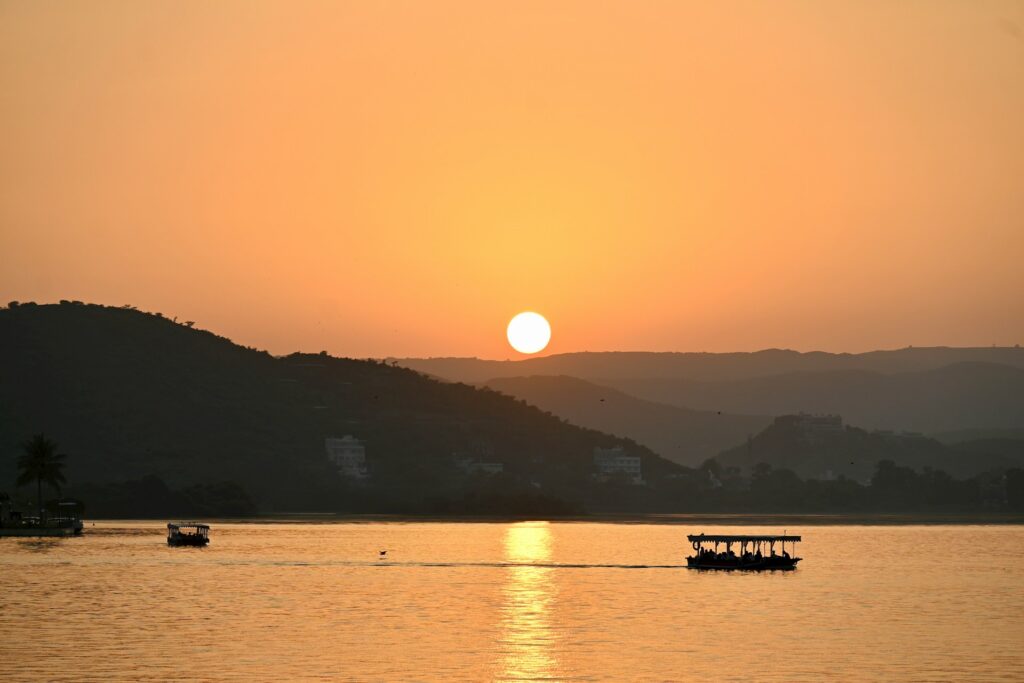
History:
Built in 1362 AD by the gypsy tribesman Banjara, Lake Pichola was further developed by Udaipur’s creator, Maharana Udai Singh II. The lake continued to serve as a vital resource for the neighborhood and functioned as a vital water storage for the city.
Scenic Beauty:
Lake Pichola, surrounded by verdant hills, historic temples, and opulent mansions, provides sense-pleasing vistas. During the day, guests are captivated by the captivating vista that is created when the lake’s glistening waters reflect the hues of the sky.
Attractions:
Jag Mandir: This magnificent palace provides a peaceful haven among the calm waters. It is perched on an island in the center of Lake Pichola.
Jag Niwas: Also referred to as the Lake Palace, Jag Niwas is a famous hotel that adds to the attraction of the lake by appearing floating on its surface.
Ghats: The ghats at the lake’s edge offer a tranquil place for visitors and locals to unwind, go for a boat trip, or see the gorgeous sunset over the water.
Boat Rides: Taking a boat trip is one of the best ways to appreciate Lake Pichola’s natural beauty. The traditional wooden boats, called “shikaras,” glide smoothly over the calm waters, providing stunning views of the surrounding area and famous sites.
Sunset Views: As the sun sets, Lake Pichola becomes a rainbow of shades that covers the city in a magnificent brightness. Watching the sunset from the shores of Lake Pichola is an unforgettable memory for tourists.
Visitor Experience:
Lake Pichola provides a singular and remarkable experience for guests of all ages, whether they choose to stroll along the lakeside avenue, see the ancient sites dotted along its borders, or just take in the peacefulness of its waters.
Practical Information:
Boat Rides: Throughout the day, Lake Pichola offers boat rides with the option of private charters or guided tours.
Sunset Point: The evening is the ideal time to see the sun set over Lake Pichola, so go there early to get a good place.
Conclusion:
Lake Pichola is more than simply a body of water; it is the spirit of Udaipur, inspiring, calming, and enchanting visitors for generations. A trip to Lake Pichola is a must for anyone wanting to fully experience the charm of Udaipur, whether it is for leisurely boat rides, touring its historic sites, or simply taking in the breathtaking scenery.
3. Sajjangarh Palace : The Iconic Sunset Retreat
Sajjangarh Palace, also called the Monsoon Palace, is perched atop the Aravalli Hills on the outskirts of Udaipur, Rajasthan, and provides stunning views of the surrounding area and the city below.
This is the must visit places during your Udaipur Visit.
History
Sajjangarh Palace was designed as a hunting lodge and summer getaway for the royal family when it was constructed in the late 19th century by Maharana Sajjan Singh of the Mewar dynasty. But the Maharana’s palace was never finished, and his successors used it for different reasons after his death.

Architecture:
Sajjangarh Palace is a superb illustration of Rajput architecture, distinguished by its sophisticated carvings, balconies, and domes. The palace, which is mostly made of white marble and sandstone, has an air of imperial majesty and beauty.
In addition to taking in the palace’s striking architectural details, visitors can explore its various rooms, courtyards, and terraces, each of which provides a different view of the surrounding area.
Highlights:
Sunset Point: With the sun bathing the city and the surrounding hills in a golden glow, the palace is well known for providing some of the most breathtaking sunset views in all of Udaipur.
Wildlife Sanctuary:
The Sajjangarh Wildlife Sanctuary, which is surrounded by the palace, is home to a variety of animals and plants, including deer, leopards, and migratory birds.
Visitor Experience:
Sajjangarh Palace offers visitors the chance to take calm and beautiful breaks from the busy city below, as well as possibilities for birdwatching, natural walks, and photography. Both locals and visitors enjoy visiting the palace because of its serene atmosphere and expansive views.
Practical Information:
Opening Hours: Sajjangarh Palace is open to visitors from 9:00 AM to 6:00 PM every day.
Entry Fee: The entry fee varies for Indian and international tourists, with additional charges for camera usage.
Accessibility: The palace is accessible by road, with parking facilities available at the base of the hill. Visitors can reach the palace by hiking or taking a taxi or auto-rickshaw.
Conclusion:
Sajjangarh Palace is a viewpoint point from which to take in the majesty and natural beauty of Udaipur and its surrounds, not just a historical landmark. Travelers seeking peace and calm amid Rajasthan’s royal legacy can expect a wonderful experience at Sajjangarh Palace, whether they choose to explore the palace’s architecture, watch the sunset, or spend time in the wildlife sanctuary.
4. Bagore Ki Haveli : A Glimpse into Udaipur's Rich Heritage
Bagore Ki Haveli is nestled on the eastern shore of Lake Pichola in Udaipur, Rajasthan, offering a captivating insight into the city’s cultural legacy.
History:
Built in the 18th century by the prime minister of Mewar, Bagore Ki Haveli stands as a testament to the opulent lifestyle and architectural finesse of the past era.
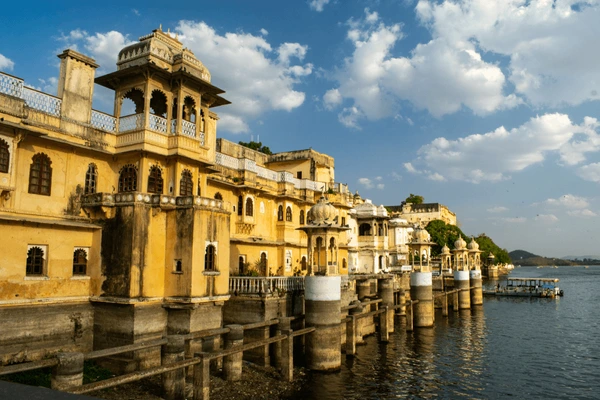
Architecture:
The haveli is a magnificent example of Rajput architecture, with complex carvings, colorful artwork, and intricate balconies that highlight the magnificence of Rajasthani craft skills.
Cultural Extravaganza:
Bagore Ki Haveli offers visitors the opportunity to fully experience Udaipur’s rich cultural legacy through a variety of lively cultural events, like folk dances, puppet plays, and performances of traditional music.
Museum Exhibits:
A rich collection of antiquities, including antique furniture, royal costumes, and traditional household goods, are on display in the haveli’s museum, providing an insight into the way of life of the Mewar royalty.
Scenic Views:
Bagore Ki Haveli, perched on the banks of Lake Pichola, is a gorgeous location for nature lovers and photographers, with expansive views of the lake and its surroundings.
Visitor Experience:
Visitors who want to learn more about Udaipur’s rich cultural heritage can plan a visit to Bagore Ki Haveli. Visitors may fully immerse themselves in the lively past of the city by doing everything from touring the museum’s exhibits to taking in engaging cultural performances.
Practical Information:
Opening Hours: Bagore Ki Haveli is open to visitors from 10:00 AM to 6:00 PM every day.
Entry Fee: The entry fee varies for Indian and international tourists, with additional charges for cultural performances.
Accessibility: The haveli is easily accessible by road and is located in proximity to other popular attractions in Udaipur.
Conclusion:
Offering guests an engrossing trip through the city’s glorious past, Bagore Ki Haveli is a living tribute to Udaipur’s rich cultural legacy. A visit to Bagore Ki Haveli is a must throughout your Udaipur vacation experience, regardless of your interests in history, art, or just getting lost in the spirit of the city.
5. Fateh Sagar Lake : A Calm Haven in the Center of the City
Fateh Sagar Lake, a serene body of water that enhances the attractiveness and attraction of Udaipur, Rajasthan, lies tucked away among the Aravalli Hills.
Description:
One of the most well-known lakes in Udaipur, Fateh Sagar Lake, offers an oasis of calm from the rush of the city. The lake, which is approximately one square kilometer in size, is encircled by beautiful hills and verdant vegetation, providing guests with a magnificent setting.
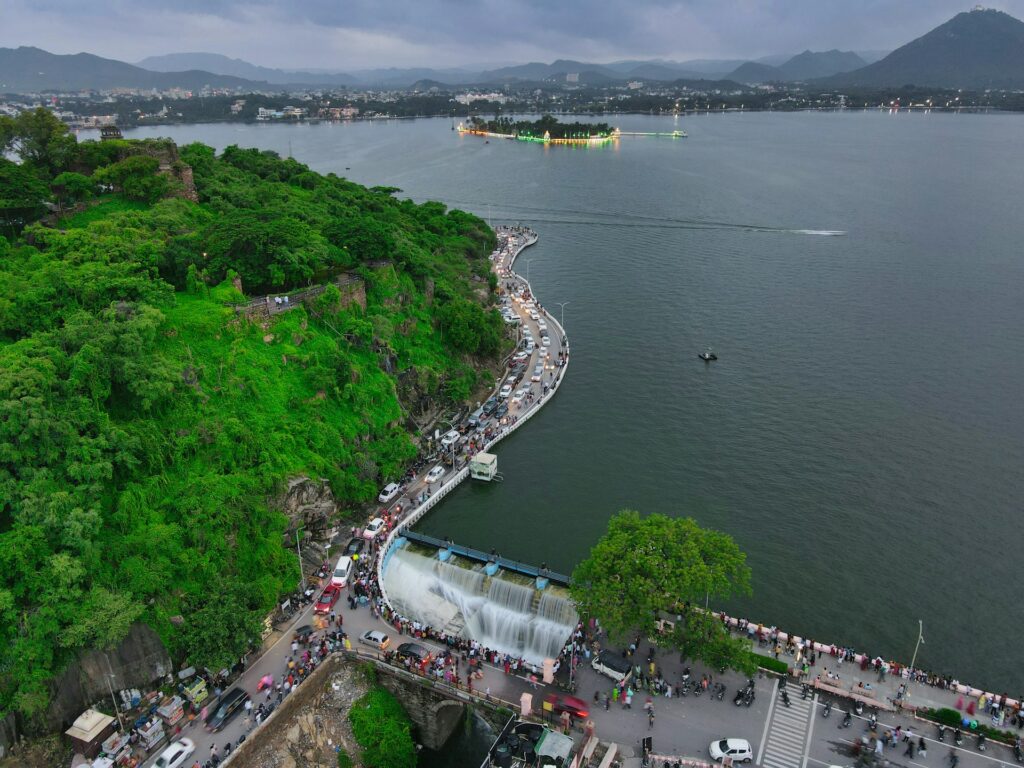
History:
Fateh Sagar Lake was first created by Maharana Jai Singh in the 17th century to supply water for drinking and irrigation. It has grown in popularity as a vacation resort and a locals’ go-to place to decompress over time.
Attractions:
Nehru Park: Situated on an island in the center of the lake, Nehru Park is a well-liked picnic area and recreational area where guests may take leisurely walks, boat rides, and picnics amid well-kept lawns and flowers.
Jet Fountain: The Lake is famous for its magnificent jet fountain, which sprays water up to 25 meters in the air and produces an enthralling sight, particularly in the evening when it is lit up with bright lights.
Surrounding Attractions: There are a number of attractions surrounding Fateh Sagar Lake, such as the Maharana Pratap Memorial, which pays tribute to the fabled Rajput warrior, and the picturesque Moti Magri Hill, which provides expansive views of the city and the lake.
Activities:
Activities available to tourists to Fateh Sagar Lake include jet skiing, pedal boating, and boating, all of which provide a distinctive viewpoint of the lake and its environs. The lake’s serene atmosphere also makes it a great place for birdwatching, photography, and meditation.
Accessibility:
Fateh Sagar Lake is easily accessible from the city center of Udaipur, with ample parking facilities available for visitors. Boat rides are available throughout the day, allowing visitors to explore the lake at their leisure.
Visitor Experience:
Visitors who want to learn more about Udaipur’s rich cultural heritage can plan a visit to Bagore Ki Haveli. Visitors may fully immerse themselves in the lively past of the city by doing everything from touring the museum’s exhibits to taking in engaging cultural performances.
Conclusion:
In the center of Udaipur, Fateh Sagar Lake is more than just a lake—it’s a haven of peace and scenic splendor. A trip to Fateh Sagar Lake guarantees an amazing experience for everyone, whether your goals are to take in the breathtaking scenery, engage in water sports, or just relax in the middle of nature
6. Jag Mandir Palace : A Serene Oasis in the Heart of the City
A captivating island castle with a timeless elegance and grandeur, Jag Mandir castle is located in Udaipur, Rajasthan, on the serene waters of Lake Pichola.
History:
The Mewar royals used Jag Mandir Palace, which Maharana Karan Singh erected in the 17th century, as a summer resort. It has seen hundreds of years of history, entertaining notable visitors and taking in momentous occasions.

Architecture:
The palace, with its majestic roofs, beautifully carved pillars, and marble pavilions that capture the splendor of the Mewar dynasty, is a masterpiece of Rajput architecture. The palace’s architecture skillfully combines Rajput and Mughal elements to provide a visually stunning spectacle that charms guests.
Highlights:
Garden Courtyard: Nestled amid the glittering waters of Lake Pichola, the palace boasts a picturesque garden courtyard with fountains, rich flora, and marble sculptures that provide a tranquil haven.
Darikhana Restaurant: Dine in elegance while taking in expansive lake views and delectable Rajasthani fare in opulent surroundings at the Darikhana Restaurant.
Gul Mahal: Also known as the Flower Palace, the Gul Mahal is an architectural wonder with elaborate floral themes, marble arches, and elaborate balconies that provide a window into the opulent way of life enjoyed by the royal occupants.
Visitor Experience:
A guided tour of Jag Mandir Palace’s grounds is available for anyone who wishes to see its opulent halls, verdant gardens, and historical treasures. To further enhance its appeal and attraction, the palace now organizes weddings and other special celebrations in addition to cultural activities.
Practical Information:
Access: Jag Mandir Palace is accessible by boat from the City Palace or the shores of Lake Pichola in Udaipur. Boat rides offer a scenic journey across the lake, with breathtaking views of the surrounding hills and palaces.
Timing: The palace is open to visitors from morning till evening, allowing ample time to explore its beauty and soak in the tranquility of its surroundings.
Events: Jag Mandir Palace hosts various events throughout the year, including music concerts, art exhibitions, and cultural performances, providing visitors with an immersive experience of Rajasthan’s vibrant culture.
Conclusion:
Offering guests a window into the opulence of a bygone period, Jag Mandir Palace is a monument to the majesty and grace of Rajasthan’s royal heritage. A visit to Jag Mandir Palace is an absolutely unique experience that takes you to a realm of timeless beauty and grace with its breathtaking architecture, picturesque surroundings, and rich history.
7. Saheliyon Ki Bari
Saheliyon ki Bari is a peaceful garden oasis on the banks of Fateh Sagar Lake, hidden away in the center of Udaipur, Rajasthan.
History:
Saheliyon ki Bari was a retreat for the queen and her friends, constructed in the 18th century by Maharana Sangram Singh II for the royal ladies of the court.

Architecture:
The park, which has rich plants, marble pavilions, beautifully carved fountains, and peaceful water features, is a masterwork of Rajasthani design and gardening. The symmetrical arrangements and geometric patterns are reminiscent of the old Mughal and Rajput designs.
Highlights:
Lotus Pool: The lotus pool, which is encircled by marble pavilions and embellished with water fountains and sculptured elephants, is the focal point of Saheliyon ki Bari.
Fountains: There are numerous lovely fountains scattered throughout the area, including one special fountain that runs without the need of any mechanical assistance.
Marble Pavilion: The white marble pavilions in the garden provide tourists with shady areas to unwind with intricate carvings and latticework.
Floral Displays: Saheliyon ki Bari is well known for its vibrant flowerbeds and well-kept landscaping, which combine to create a calm and charming atmosphere.
Visitor Experience:
Saheliyon ki Bari offers visitors the opportunity to take slow walks around the peaceful setting while taking in the stunning flowers, verdant foliage, and architectural marvels. The garden is a well-liked location for picnics, leisurely strolls, and photography, since it provides a tranquil haven from the bustle of the city.
Practical Information:
Opening Hours: Saheliyon ki Bari is open to visitors from 9:00 AM to 6:00 PM every day.
Entry Fee: There is a nominal entry fee for Indian and international tourists, with additional charges for camera usage.
Accessibility: The Park is wheelchair accessible, with paved pathways and ramps for easy navigation.
Conclusion:
Saheliyon ki Bari is more than just a garden; it’s a vibrant example of Udaipur’s royal past and its serene beauty. A trip to Saheliyon ki Bari transports visitors back to the heyday of Rajasthani royalty with its verdant surroundings, tranquil lakes, and magnificent buildings.
8. Jaisamand Lake : Exploring the Second Largest Artificial Lake in Asia
Situated in the Aravalli Hills, Jaisamand Lake, also called Dhebar Lake, is roughly 48 kilometers away from Udaipur in Rajasthan. It provides a tranquil haven from the bustle of the city.
History:
Historically significant as the second-largest artificial lake in Asia, Jaisamand Lake in Udaipur was built in the 17th century by Udaipur’s king, Maharana Jai Singh. The lake was created to honor the building of the Rana’s dam across the Gomti River and to supply water for cultivation.
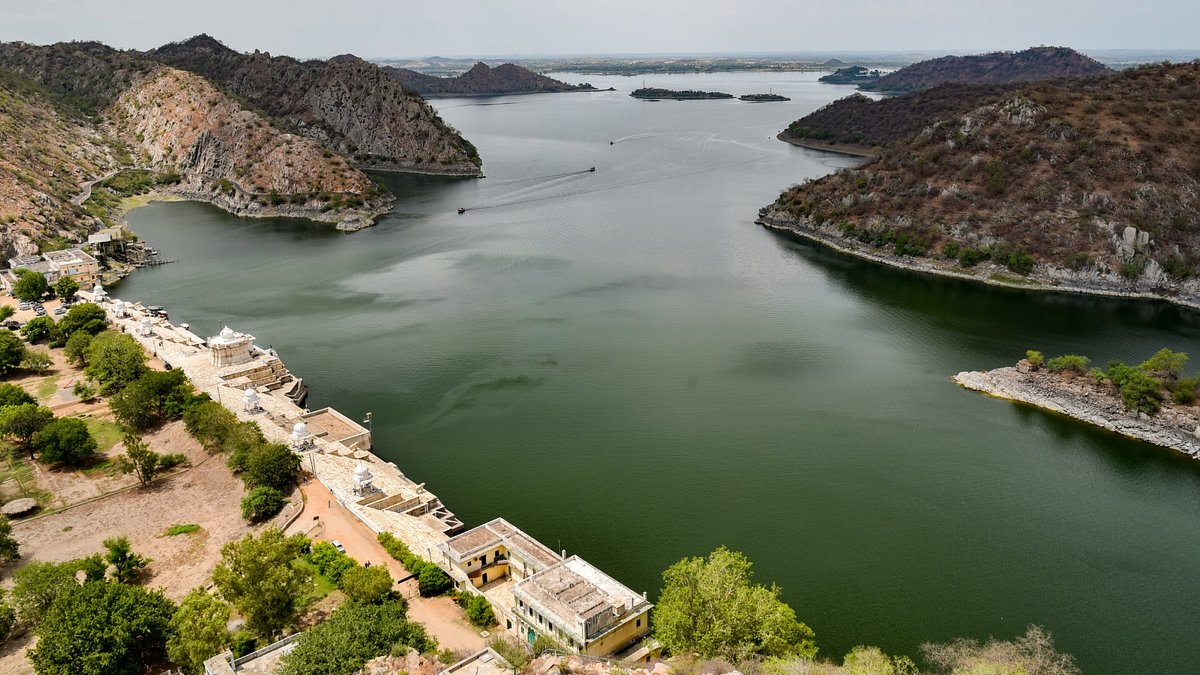
Size and Features:
Encompassing an astonishing 87 square kilometers, Jaisamand Lake is a wide expanse of dazzling blue waters encircled by steep hills and rich vegetation. Several islands surround the lake, the largest of which is called Babaka Bhagra and is home to a charming palace and a temple to Lord Shiva.
Attractions:
Jaisamand Wildlife Sanctuary: The lake is surrounded by the Jaisamand Wildlife Sanctuary, which is home to a wide range of migratory birds, deer, leopards, and wild boars.
Hilltop Temples: Explore the historic hilltop temples honoring Hindu gods such as Lord Shiva and Goddess Durga, which provide sweeping views of the lake and its environs.
Marble Chhatris: Admire the elaborate marble chhatris (cenotaphs) honoring the bravery and valor of the Rajput warriors that have been erected along the lake’s edge.
Activities:
Boat Cruises: Take leisurely boat rides on Jaisamand Lake’s immaculate waters, which give stunning views of the nearby hills and islands.
Picnicking: With lots of shade and beautiful views to take in, the lake’s charming surroundings make it a great place to unwind and have picnics.
Birdwatching: The sanctuary is a great place to see a wide range of resident and migratory bird species, especially in the winter.
Practical Information:
Accessibility: Jaisamand Lake is accessible by road from Udaipur, with taxis and private vehicles being the most convenient mode of transportation.
Entry Fee: There may be a nominal entry fee for visiting certain areas around the lake, such as the wildlife sanctuary and temples.
Best Time to Visit: The best time to visit Jaisamand Lake is during the winter months, from October to March, when the weather is pleasant and ideal for outdoor activities.
Conclusion:
Jaisamand Lake is more than just a body of water; it’s a serene haven where the splendor of the natural world is revealed. In the heart of Rajasthan’s breathtaking scenery, a visit to Jaisamand Lake guarantees an amazing experience, whether you’re looking for adventure, tranquility, or just a change of pace.
9. Shilp Gram : Preserving Rajasthan's Artistic Heritage
Shilpgram is a rural arts and crafts complex located just 3 kilometers west of Udaipur, Rajasthan, near Havala village.
Purpose and Concept:
Dedicated to safeguarding and advancing Rajasthan’s rich artistic legacy, Shilpgram functions as a cultural center where customary artists and craftspeople exhibit their abilities and market their handcrafted goods.
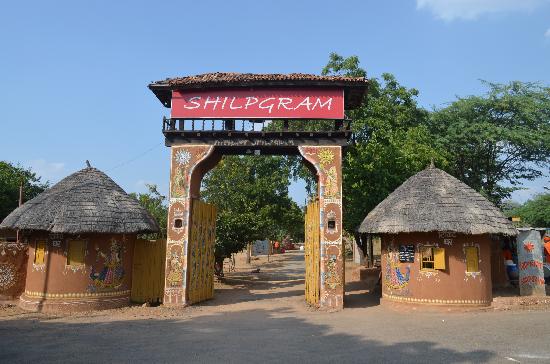
Architecture and Layout:
The complex is styled to mimic a typical Rajasthani village, complete with thatched roofs, narrow alleyways, and mud houses that provide a genuine sense of place. Many artisan workshops, performance rooms, exhibition spaces, and a central courtyard for cultural activities are all part of Shilpgram’s plan.
Artisans and Crafts:
Craftspeople from all across Rajasthan, with specialties including ceramics, weaving, needlework, metalwork, wood carving, and puppetry, call Shilpgram home. In addition to interacting with the craftspeople, visitors may see them at work and buy genuine handcrafted mementos straight from them.
Cultural Events and Performances:
Shilpgram celebrates Rajasthan’s rich cultural legacy all year long with a range of festivals, concerts, and performances. The complex offers theater productions, puppet shows, folk music and dance acts, and traditional Rajasthani food for visitors to enjoy.
Shopping and Souvenirs:
For those looking to purchase genuine Rajasthani goods and mementos, Shilpgram is a shopping haven. Using ancient techniques, talented artists create a wide range of handcrafted objects like textiles, jewelry, pottery, paintings, and home decor items, which are sold at several booths and shops within the complex.
Visitor Experience:
A trip to Shilpgram provides a singular chance to experience Rajasthan’s thriving arts and crafts industry, engage with regional craftspeople, and learn about the region’s rich cultural legacy. The complex is a great spot to explore and discover the essence of rural Rajasthan because of its laid-back and rustic vibe.
Practical Information:
Opening Hours: Shilpgram is open to visitors from 11:00 AM to 7:00 PM every day.
Entry Fee: There is a nominal entry fee for Indian and international tourists, with additional charges for certain activities and workshops.
Accessibility: The complex is wheelchair accessible, and guided tours are available for visitors who wish to learn more about the artisans and their crafts.
Conclusion:
Shilpgram is more than just a tourist destination; it is a dynamic homage to Rajasthan’s creative past and a demonstration of the talent and ingenuity of its craftspeople. A trip to Shilpgram offers more than simply retail therapy—it’s a chance to engage with Rajasthan’s rich cultural fabric and help sustain the lives of regional craftspeople.
For More visit : Click Here

